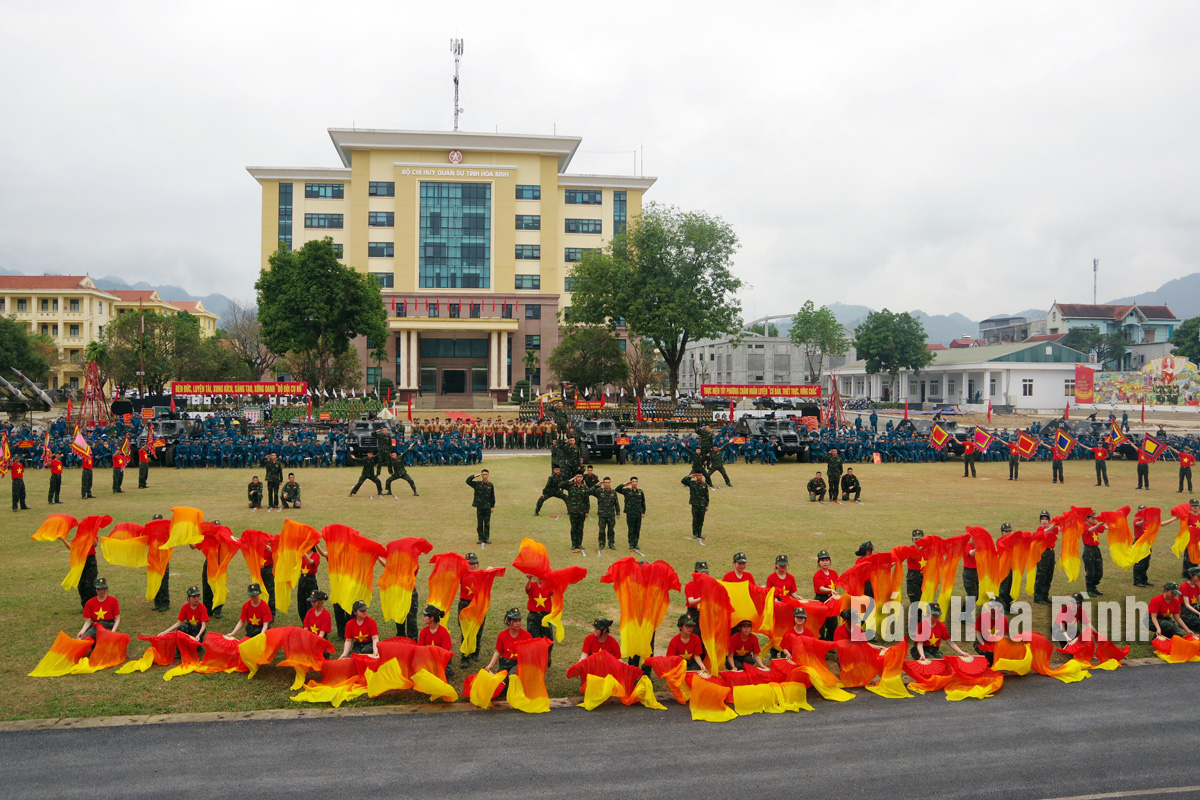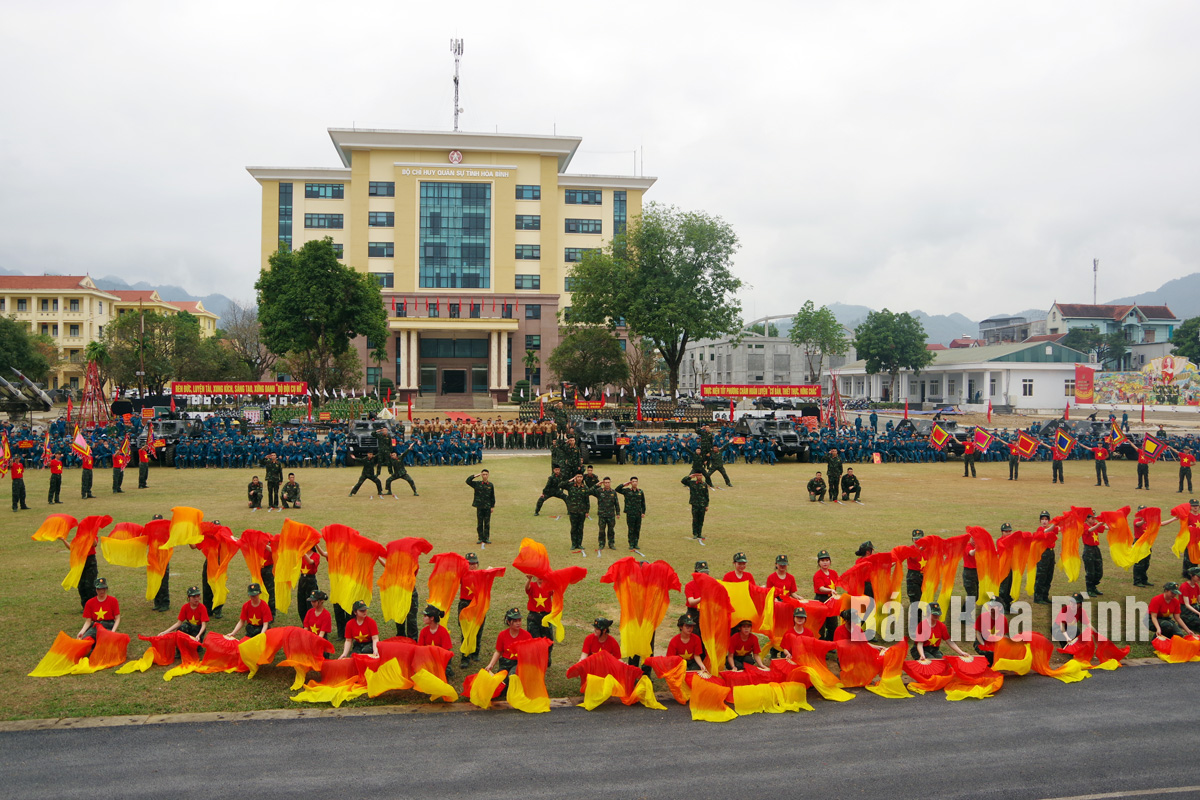
In the millennia-long history of national construction and safeguarding, people of all ethnic groups in Hoa Binh have been united and closely bound together to overcome all difficulties and challenges, standing alongside the entire Vietnamese people throughout the history of building and defending the country.
People of all ethnic groups in Hoa Binh have stayed steadfast in accompanying the entire people in the cause of national building and defence. Photo taken at the 2025 training launch ceremony.
Although Hoa Binh was not a battlefield or the site of major battles in history, according to Professor of History Le Van Lan, through research and historical records, it is clear that in every era, people of all ethnic groups living in Hoa Binh made significant contributions to the struggles for national independence and defence.
One of them was Dinh Quy Khiem, the eldest son of a mandarin of the Muong Dong region. According to historical records and the family annals of the Dinh Cong clan in the Muong Dong region (Kim Boi district), the ancestor of the Dinh clan – Dinh Nhu Lenh (1365 - ?), during the later years of King Tran Du Tong's reign (1341–1369), had two children: Dinh Quy Khiem and Dinh Van Hung. Khiem then succeeded his father as the head of Muong Dong.
When Le Loi led an uprising in Lam Son (an area now in Thanh Hoa province) in 1426, marching north to drive out the Ming invaders, Khiem brought his "mountain troops" to support the king and achieved numerous victories. The "mountain troops" participated in battles and secured many triumphs in Tot Dong, Chuc Dong, Co Lam - Ninh Kieu, and laid siege to Dong Quan (now Hanoi), forcing the Ming invaders to surrender and retreat. After this victory, Le Loi ascended to the throne and appointed Khiem as "Phu quoc tuong quan Khiem nghia hau," granting him control over the Son Tay region.
After Khiem, it was the turn of Dinh Nhu Cuong (born around the mid-16th century, during the Le – Mac conflict). In March 1593, after Mac Mau Hop was defeated, King Le The Tong travelled from Tho Xuan (Thanh Hoa) to the North. While passing through a remote mountainous area, he was ambushed by assassins, and his guard couldn't defend him. In a life-threatening moment, Cuong rushed in to protect the king and saved his life. The king awarded him the title "Tien quan ho uy". Gaining many feats of arms, he was later promoted to "Phu quoc Thuong tuong quan, Uy loc hau" and assigned to guard the Kinh Bac region (now Bac Ninh province).
His son Dinh Cong Ky (born in 1582) succeeded him, serving as a military leader during King Le Than Tong's reign. He earned numerous victories and helped the king develop the administration. He became a pillar of the court and was granted the title "Do doc oai loc hau". In 1996, the ancient Dong Thech stone tomb, where he rested in peace, was recognised as a national historical and cultural relic site by the Ministry of Culture and Information.
In the 19th generation of the Dinh Cong clan, brothers Dinh Cong Huy, Dinh Cong Niet, and Dinh Cong Nhiep, after awakening to revolutionary ideals, renounced their noble titles as "quan lang" to become patriotic intellectuals. The three brothers even secretly printed counterfeit money and bought weapons to organise an uprising against the French.
An important event that greatly motivated the Dinh Cong clan and the Muong ethnic community was that in September 1949, when Dinh Cong Niet was admitted to the Indochinese Communist Party. Before that, he had received a letter of encouragement from President Ho Chi Minh and a certificate of merit from General Vo Nguyen Giap. In March 1949, a battalion was named after and led by Dinh Cong Niet, who was later appointed deputy head of Regiment 12 and took part in the liberation of Hoa Binh and the Dien Bien Phu Campaign.
The names mentioned above are just a few among many people of Hoa Binh who were willing to give up all fame, status, and wealth to fight against enemies for national construction and safeguarding.
The emulation movement "Hoa Binh joining hands to build new-style rural areas” has been widely spreading, becoming a driving force that motivates the localities to renew rural landscapes and improve the material and spiritual lives of the residents. In this movement, the people play a central role-both as the main implementers and direct beneficiaries of its outcomes.
In response to the global digital revolution, Hoa Binh Newspaper is transforming itself into a modern and multi-platform media hub, blending cutting-edge technology with a restructured newsroom and a new generation of tech-savvy journalists.
Hoa Binh province’s Association of the Elderly recently held a conference to review the project on expanding the inter-generation self-help club model until 2025.
In a move to implement Resolution No. 57-NQ/TW, issued on December 22, 2024 by the Politburo, which targets breakthroughs in science-technology development, innovation, and digital transformation, the Hoa Binh provincial Department of Health has issued a plan to roll out the "Digital Literacy for All” campaign within the local health sector.
An Nghia Commune (Lạc Sơn District) is one of the communes that achieved the tha standard of the national new rural area in 2018. Entering a new development phase, the commune is now trying to meet the criteria for the advanced new rural development. With the strong political will and the public consensus, the commune is gradually overcoming the challenges to reach this goal, aiming for the sustainable development.



